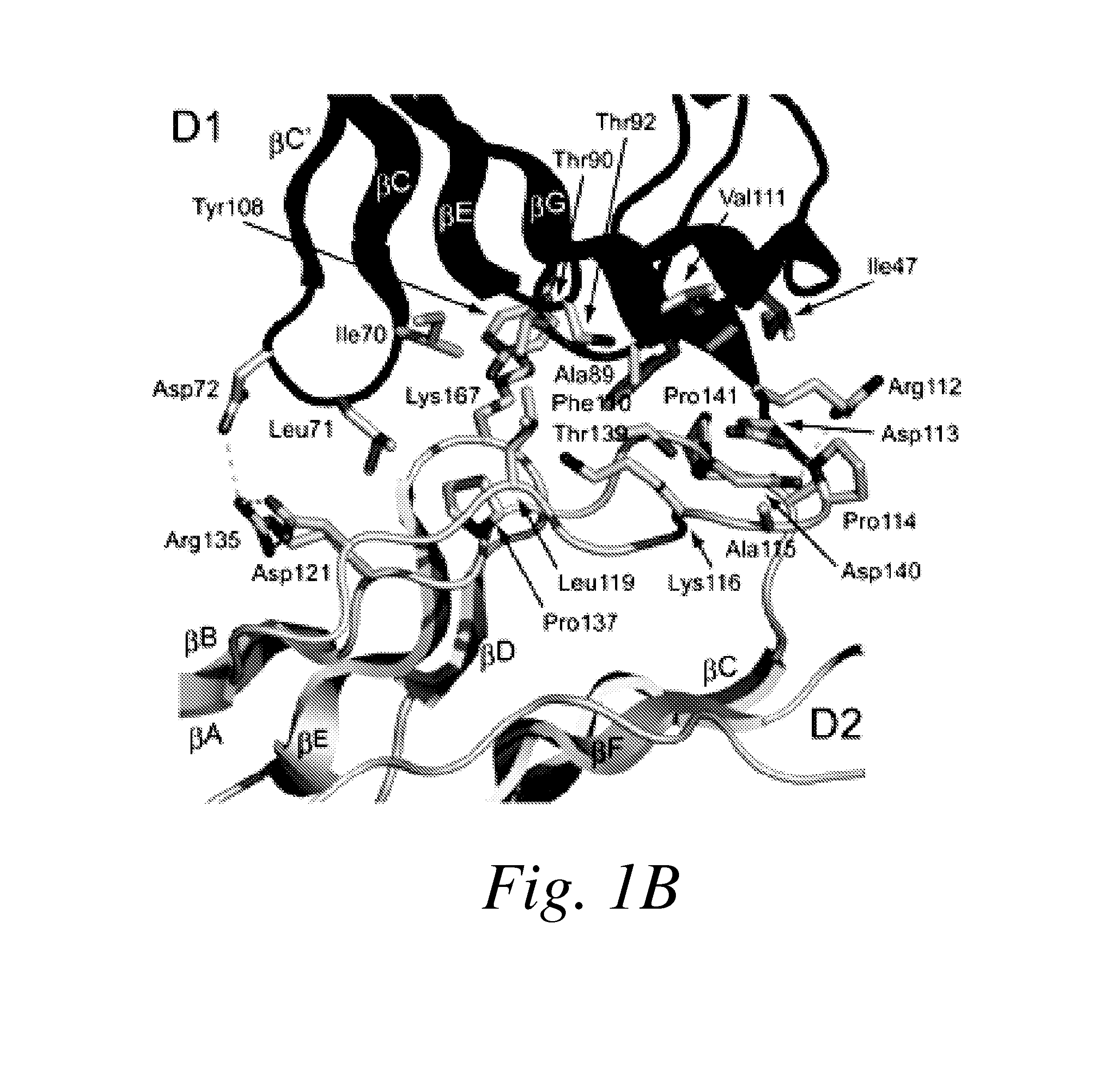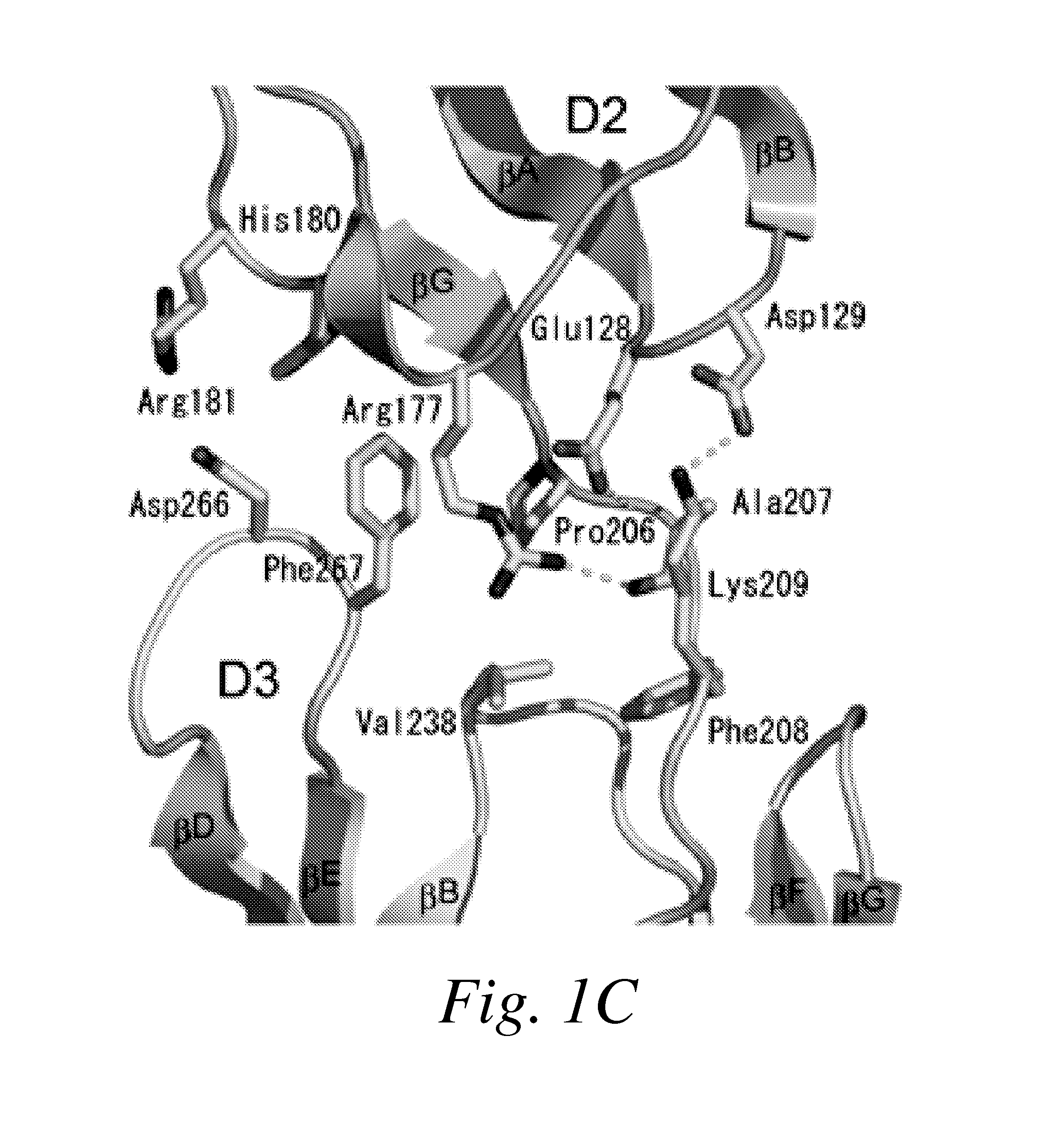Inhibitors of vascular endothelial growth factor (VEGF) receptors and methods of use thereof
a technology of vascular endothelial growth factor and receptor, which is applied in the direction of peptides, drug compositions, and infusion cells, can solve the problems of no moiety, and achieve the effects of inhibiting the activity of vegf receptors
- Summary
- Abstract
- Description
- Claims
- Application Information
AI Technical Summary
Benefits of technology
Problems solved by technology
Method used
Image
Examples
examples 1-19
Introduction to Examples 1-19
[0374]Stem cell factor (SCF) is a cytokine that mediates its diverse cellular responses by binding to and activating the receptor tyrosine kinase Kit (also known as SCF-receptor). Kit was initially discovered as an oncogene in a feline retrovirus that captured an activated and truncated form of the surface receptor (Besmer et al. (1986) J Virol 60: 194-203.). SCF is encoded by the murine steel (SI) locus while Kit is encoded by the dominant white spotting (W) locus in the mouse (Copeland et al. (1990) Cell 63: 175-183; Huang et al. (1990) Cell 63: 225-233; Flanagan and Leder (1990) Cell 63: 185-194.; Tan et al. (1990) Science 247: 209-212; Bernstein et al. (1990) Ciba Found Symp 148: 158-166; discussion 166-172). SCF functions as a non-covalent homodimer and both membrane-anchored and soluble forms of SCF generated by alternative RNA splicing and by proteolytic processing have been described (reviewed in Ashman (1999) Int J Biochem Cell Biol 31:1037-1051...
example 1
Expression, Purification and Crystallization of SCF and Kit
[0379]The entire ectodomain of Kit composed of five Ig-like domains designated D1, D2, D3, D4 and D5 was expressed in insect cells using the baculovirus expression system. Purified Kit ectodomain monomers or SCF-induced Kit ectodomain homodimers (SCF-Kit 2:2 complex) were each subjected to extensive screening for crystal growth and optimization followed by determination of their crystal structures.
Protein Expression and Purification
[0380]A soluble Kit ectodomain (amino acids 1-519) containing a poly-histidine tag at the C-terminus was expressed in insect cells (Sf9) using the baculovirus expression system. Kit ectodomain was purified by Ni-chelate followed by size-exclusion chromatography (Superdex 200, GE Healthcare). After partial deglycosylation using endo-glycosidase F1, the ectodomain was further purified by anion exchange chromatography (MonoQ, GE Healthcare). SCF (1-141) was expressed, refolded and purified as previou...
example 2
Structure Determination
[0384]The experimental phases were calculated by using multiple isomorphous replacement with anomalous scattering (MIRAS) and by multi-wavelength anomalous diffraction (MAD) to 3.0 Å resolution (Table 1A). The resulting electron-density maps showed continuous electron density of β sandwich structures, and clear solvent-protein boundaries. The molecular model of monomeric Kit ectodomain was built manually into the experimental electron density maps. The structure was refined to a 3.0 Å resolution using the native data set to a crystallographic R-factor of 25.4% and free R-factor of 29.6% (Table 1B). The structure of SCF-Kit 2:2 complex was solved by molecular replacement using the structure of the monomeric form described in this report and the structure of SCF (Zhang et al. (2000) Proc Natl Acad Sci USA 97: 7732-7737; retrievable from the Protein Data Bank with code: 1EXZ) as search models. The structure was refined to 3.5 Å resolution using the native data se...
PUM
| Property | Measurement | Unit |
|---|---|---|
| Length | aaaaa | aaaaa |
| Fraction | aaaaa | aaaaa |
| Molar density | aaaaa | aaaaa |
Abstract
Description
Claims
Application Information
 Login to View More
Login to View More - R&D
- Intellectual Property
- Life Sciences
- Materials
- Tech Scout
- Unparalleled Data Quality
- Higher Quality Content
- 60% Fewer Hallucinations
Browse by: Latest US Patents, China's latest patents, Technical Efficacy Thesaurus, Application Domain, Technology Topic, Popular Technical Reports.
© 2025 PatSnap. All rights reserved.Legal|Privacy policy|Modern Slavery Act Transparency Statement|Sitemap|About US| Contact US: help@patsnap.com



